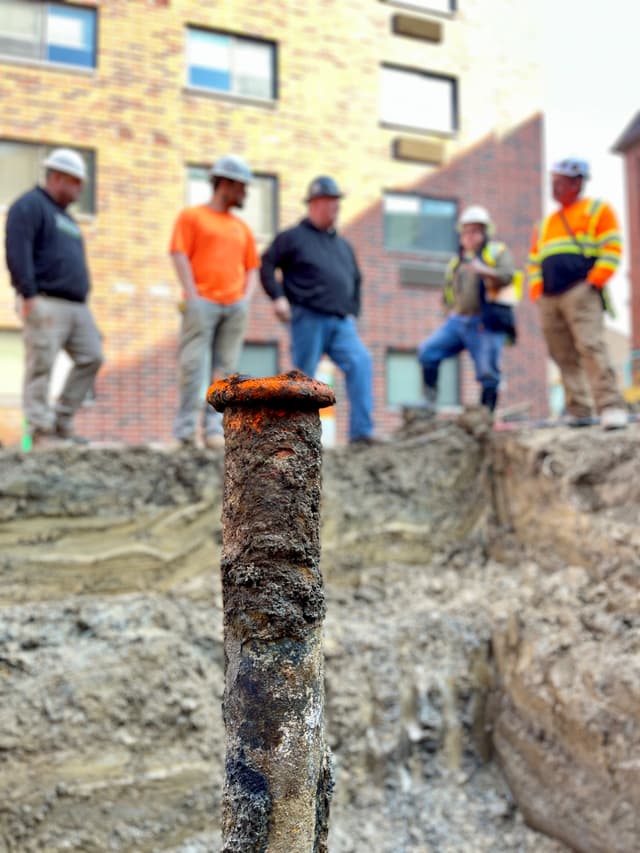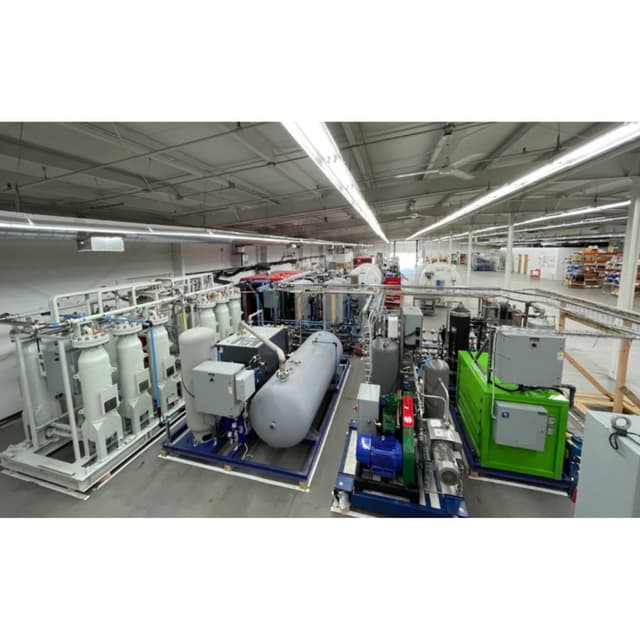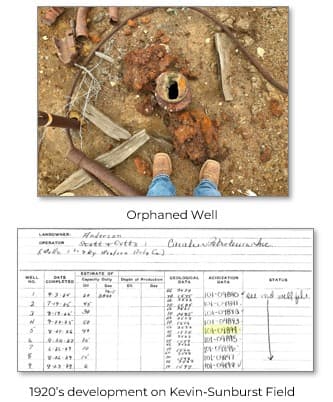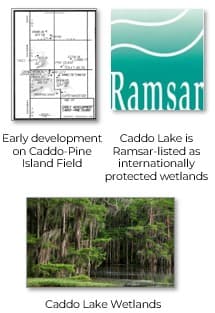New Frontier Markets
Marketplace
Search through the projects and transact with leading project developers. All projects undergo rigorous monitoring and verification by trusted third parties.

Our Lady of the Angels Orphan Well
Located above the Rocky River in the City of Cleveland, in Cuyahoga County, Ohio this orphaned well was drilled in 1908 into what was likely the “Clinton Formation”. As one of Ohio’s oldest natural gas bearing shale formations, to a depth of approximately -2,700’+/-. The well (API: 340-35-60778) was producing up until the 1950s when it was idled and filled with a clay material, a common industry practice during that era. Located above the Rocky River in the City of Cleveland, in Cuyahoga County, Ohio this orphaned well was drilled in 1908 into what was likely the “Clinton Formation”. As one of Ohio’s oldest natural gas bearing shale formations, to a depth of approximately -2,700’+/-. The well (API: 340-35-60778) was producing up until the 1950s when it was idled and filled with a clay material, a common industry practice during that era. In 1979, Our Lady of Angels Apartments, Inc. DBA Franciscan Village, a nonprofit collaboration, was formed to serve the anticipated future demand for affordable independent senior citizen housing. As the first residents began to occupy the two-building, 135-unit Franciscan Village, a waiting list of approximately 2,000 people soon developed. In 1992 the Franciscan Village expanded by constructing a third building and adding 41 additional units for a total of 176. An expansion project in 2022 exposed that an orphaned well was leaking methane in the courtyard and VitalEco and our partners adopted it. The Ohio Department of Natural Resources issued the plugging permit on April 8, 2022 and Moore Well Services of Mogador, OH began work. The team drilled out the old plugging material and removed the failed casing pipe. They drilled a larger diameter 8″ hole for a clean well bore and installed approximately 170′ of new 8″ steel casing which was cemented on the backside between the casing pipe and the formation. Moore then cleaned out the well bore and together with Petroset and Appalachian Well Surveys, cemented the cleaned well bore, set an 8″ bridge plug, and placed cement all the way to the surface by April 28, 2022! A team effort!
Vintages: 2022
3648 Rocky River Dr Cleveland, OH 44111

PNWCarbonRemoval
Biogenic Co2 from a waste-to-energy facility in Eastern Washington state of the US. The offtake option under development would be sequestration at a localized onsite sequestration well (pending geological testing) or at another sequestration site within the region. Initial project will remove 110,000 tons of CO2 annually, with a ramp-up to 280,000 tons per year in 3 years after the start of project. The project meets additionality requirements for carbon credit markets and will be registered with one of the leading registries. Currently the developed received funding for a full engineering feasibility study and has identified partners for local sequestration testing. The developer has commercial experience with the type of equipment at the facility. If sequestration locally is found unsuitable, the CO2 can be sold into the e-fuel or petroleum displacing products or transported by rail to another sequestration site. These backup options also have potential offtake partners already identified.
Spokane

Decarbonized Onsite Power Northeast
Onsite natural gas powered electricity source will be decarbonized by bolting on a Distributed Carbon Capture System™ to capture all the CO2 emissions from the power source. The recycled Sustainable CO2™ will then be sold locally to the food and bev market, resulting in reduced Scope 3 emissions for the CO2 buyer (a. no more long distance transport for 600-2000 miles, b. 100% of the CO2 recycled that is not commingled with virgin natural gas dome CO2 especially produced for the market).
Staten Island

Anderson 5 Orphan Well
Located in the Kevin-Sunburst Field, located in Toole County, Montana, was drilled almost 100 years ago, this orphaned Anderson 5 well (API: 25-101-09894) was drilled in 1926 to a depth of approximately 1,500 feet. Over the years, the Anderson 5 well changed operators multiple times, was not in operation in 2020, and the farm owner requested support to plug the orphaned oil well as it created a significant health and safety risk for his property, wildlife, surface environment, and nearby residents. Agriculture is the principal industry in the local area. Toole County, Montana is stretched between the Marius River and the Canadian border covering 1,946 square miles. It was created in 1914 with land taken from Hill and Teton Counties. The county gets its name from Joseph Toole who served two terms as Montana’s governor. Toole was the first governor of Montana state, serving from 1889 to 1893. Toole County was a boom area for oil production in the early and mid 20th century. In 1922, just four miles north of Kevin, oil was discovered. In the next five years, over 1,500 oil wells went into operation. The Approval to Plug was approved by the Montana Board of Oil and Gas Conservation to fill the wellbore from 1,500 feet and plugged to the surface. Enneberg Excavation from Kevin, Montana was contracted to perform the plugging work on November 11, 2021. The Inspection Report was issued on February 3, 2022 and was deemed compliant, with the well plugged, no discharge, a signed release from the farm owner was on file, the site had been restored to allow for successful farming, and no further reclamation was required.
Toole County Montana

Gish B6 Orphan Well
Located in the Caddo-Pine Island Field, located in Caddo Parrish, Louisiana, was the first very large oil and gas field discovered in Louisiana, this orphaned Gish B 006 well (LA-203133, 170-17-29936) was drilled in 1986 to a depth of approximately 4,000 feet. This orphan well is located in the Five Bayous critical wildlife habitat that is fed from Caddo Lake, an internationally protected wetlands area. The well was spudded on March 10, 1986 and drilling commenced in 1989 into the Nacatoch formation.. The well was operational from 1993 until September, 2019 when it became an orphan when the last operator, Roy D. Gish, went out of business and the well formally became the responsibility of the State of Louisiana. The first recorded use of natural gas in the area, in the late 1800’s with the Shreveport Ice Plant well where gas was used for illumination. The earliest oil pipeline in the northern Louisiana area was completed in 1910 by Standard Oil of Louisiana, connecting the oilfield to Standard’s Baton Rouge refinery. More exploratory wells quickly followed and by 1910 almost 25,000 people were working in and around Oil City, which became the first “wildcat town” in the Arkansas-Louisiana-Texas region. The Approval to Plug was approved to fill the wellbore from 4,000 feet to the surface, run a minimum of 50 feet of cement into the annulus, cut 5 feet below ground, and plug to the surface. A local plugging company was contracted to perform the plugging work on February 22, 2022. The Lease Facility Inspection Report was issued by the Louisiana Department of Natural Resources Office of Conservation on July 27, 2023 and was deemed compliant, with the well plugged, no discharge of E&P, no fire hazard, and the site restored.
Caddo Parrish Louisiana

Gish A31 Orphan Well
Located in the Caddo-Pine Island Field, located in Caddo Parrish, Louisiana, was the first very large oil and gas field discovered in Louisiana, this orphaned Gish A 31 well (LA-224093, APN 170-17-3301) was drilled in 2000 to a depth of approximately 785 feet. This orphan well is located in the Five Bayous critical wildlife habitat that is fed from Caddo Lake, an internationally protected wetlands area.. The well was spudded on June 3, 2000 and drilling commenced on June 28, 2000 into the Nacatoch formation.. The well was operational from August, 2000 until September, 2019 when it became an orphan when the last operator, Roy D. Gish, went out of business and the well formally became the responsibility of the State of Louisiana. The first recorded use of natural gas in the area, in the late 1800’s with the Shreveport Ice Plant well where gas was used for illumination. The earliest oil pipeline in the northern Louisiana area was completed in 1910 by Standard Oil of Louisiana, connecting the oilfield to Standard’s Baton Rouge refinery. More exploratory wells quickly followed and by 1910 almost 25,000 people were working in and around Oil City, which became the first “wildcat town” in the Arkansas-Louisiana-Texas region. The Approval to Plug (Reference Number 385-22-1) was approved to fill the wellbore from 785 feet to the surface, run a minimum of 50 feet of cement into the annulus, cut 5 feet below ground, and plug to the surface. A local plugging company was contracted to perform the plugging work on June 17, 2022. The Lease Facility Inspection Report was issued by the Louisiana Department of Natural Resources Office of Conservation on September 18, 2023 and was deemed compliant, with the well plugged, no discharge of E&P, no fire hazard, and the site restored.
Caddo Parrish Louisiana

Gish A35 Orphan Well
Located in the Caddo-Pine Island Field, located in Caddo Parrish, Louisiana, was the first very large oil and gas field discovered in Louisiana, this orphaned Gish A 35 well (LA-224918, API: 170-17-33112) was drilled in 2000 to a depth of approximately 755 feet. This orphan well is located in the Five Bayous critical wildlife habitat that is fed from Caddo Lake, an internationally protected wetlands area.. The well was spudded on October 26, 2000 and drilling commenced on November 15, 2000 into the Nacatoch formation. The well was operational from August 1, 2001 until September 2019 when it became an orphan when the last operator, Roy D. Gish, went out of business and the well formally became the responsibility of the State of Louisiana. The first recorded use of natural gas in the area, in the late 1800’s with the Shreveport Ice Plant well where gas was used for illumination. The earliest oil pipeline in the northern Louisiana area was completed in 1910 by Standard Oil of Louisiana, connecting the oilfield to Standard’s Baton Rouge refinery. More exploratory wells quickly followed and by 1910 almost 25,000 people were working in and around Oil City, which became the first “wildcat town” in the Arkansas-Louisiana-Texas region. The Approval to Plug was approved to fill the wellbore from 758 feet to the surface, run a minimum of 50 feet of cement into the annulus, cut 5 feet below ground, and plugged to the surface. A local plugging company was contracted to perform the plugging work on April 22, 2022. The Lease Facility Inspection Report was issued by the Louisiana Department of Natural Resources Office of Conservation on December 14, 2023 and was deemed compliant, with the well plugged, no discharge of E&P, no fire hazard, and the site restored.
caddo parrish louisiana

Sweetwater Carbon Storage Hub
Frontier Carbon Solutions operates the Sweetwater Carbon Storage Hub, a permitted sequestration field designed to serve emitters across the Mid and Mountain West. On an annual basis, there are nearly 9 million tons per year of capturable carbon emissions in southwestern Wyoming, across a variety of the state's most important industries, including trona, natural gas processing, power, and helium. The Sweetwater Carbon Storage Hub lies at the heart of the global trona industry, a unique ore that provides sodium carbonate and sodium bicarbonate for glass manufacturing, pharmaceuticals, detergents, and food-grade ingredients used across the world. As this and neighboring industries pursue 2030 and 2050 net zero goals via carbon capture, Frontier Carbon Solutions will provide carbon management services for all captured CO2 into safe, permanent sequestration. For many of the state’s industries, decarbonization can only be achieved through largescale carbon capture and sequestration.
Granger, Wyoming

Milestone CO2 Slurry Injection
Milestone operates the largest network of slurry injection facilities in the U.S., offering advanced sequestration solutions that permanently trap hydrocarbons from our customers' waste a mile beneath the Earth’s surface. This process prevents the hydrocarbons from volatilizing into the air as emissions, which would naturally occur if the waste were disposed of through traditional methods like reserve pits and landfarming. The reduction in emissions realized by using our waste sequestration technology significantly exceeds the emissions generated from our operational activities, providing a substantial net carbon benefit. Our proprietary process ensures compliance with regulations, and provides E&P companies with a robust solution to significantly reduce the risks of soil and groundwater contamination while lowering operational carbon footprints. Milestone enables energy companies to adopt a cleaner, more responsible approach to waste management. Milestone maintains a rigorous monitoring, reporting, and verification program to ensure a full accounting of carbon that is deposited into our Class II wellbores. We have conducted extensive sampling across our portfolio of assets to monitor and quantify the total petroleum hydrocarbon content, and are currently engaging with third-party independent carbon registry boards to develop our own methodology to undertake the project.
6605 FM1583, Dilley, TX 78017

Project Sprint
Frontier Carbon Solutions (Frontier) is leading the decarbonization of the agricultural industry by partnering to provide carbon management services to numerous refineries across the Midwestern United States. Frontier will utilize liquefaction capture technology, an efficient process to separate high-purity (>90%) CO2 exhaust from fermenters, to capture over 400,000 tons per annum of CO2. Once the CO2 is converted into a liquid, Frontier will leverage existing rail infrastructure to transport these emissions to Granger Carbon Terminal, a dedicated CO2 rail offload facility being developed by Frontier. From the terminal, the CO2 is injected into Frontier-owned pipeline, where it is transported approximately two miles to the injection site for permanent sequestration. This project represents one of the only viable opportunities to move megatons of CO2 interstate for storage prior to 2030. Our approach is collaborative, highly scalable, and near-term. Frontier will minimize newbuild construction and extensive environmental disruption to local landowners and farmers by leveraging the United States’ existing rail infrastructure and can provide the only option for decarbonization for many biogenic sources of CO2. This project is additional, and we will require CDR to continue our progress. For more information, please reach out to Pawan Gupta at pgupta@frontierccus.com
Granger, WY